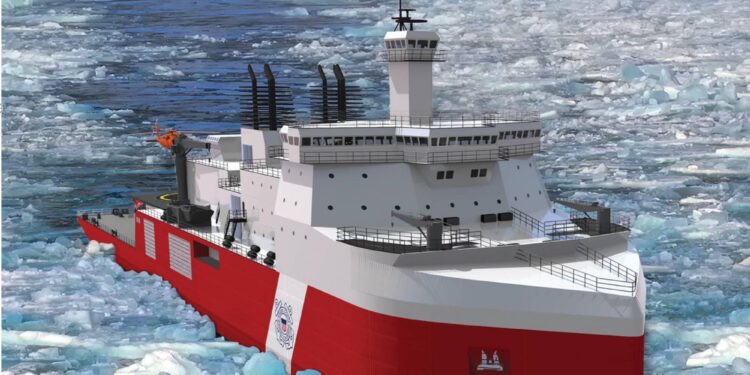Finland is set to commence construction on a state-of-the-art icebreaker for the United States following the recent signing of a landmark agreement, Bloomberg reports. The deal marks a significant milestone in transatlantic cooperation on Arctic operations, reflecting growing interest in polar navigation and strategic maritime capabilities. With its renowned expertise in icebreaker technology, Finland is poised to deliver a critical asset that will enhance the U.S. Coast Guard’s ability to operate in increasingly accessible yet challenging icy waters.
Finland Commences Icebreaker Construction Following Landmark Agreement with United States
Finland has officially embarked on the construction of a new state-of-the-art icebreaker vessel destined for the United States, marking a significant milestone in transatlantic collaboration. The project comes in the wake of a recently signed agreement that aims to enhance Arctic navigation capabilities and promote sustainable maritime operations in northern waters. This partnership blends Finnish engineering expertise with strategic U.S. interests in the polar regions, signaling a deepening of bilateral ties centered around climate resilience and security.
The new icebreaker, designed to withstand some of the harshest ice conditions on the planet, will feature:
- Advanced hull technology for improved icebreaking efficiency
- Eco-friendly propulsion systems minimizing environmental impact
- Cutting-edge navigation equipment optimized for Arctic operations
| Specification | Details |
|---|---|
| Length | 130 meters |
| Ice Class | Polar Class 4 |
| Power Output | 25 MW |
Strategic Importance of Icebreaking Capabilities in Arctic Navigation Explored
The Arctic’s increasingly accessible sea routes have amplified the necessity for advanced icebreaking vessels, positioning them as critical assets for national security, commercial shipping, and scientific exploration. Icebreakers not only enable year-round navigation but also ensure safe passage through treacherous, ice-covered waters. With climate change accelerating Arctic ice melt, the window for navigation is expanding, prompting nations like the United States to modernize their fleets. Finland’s expertise in icebreaker technology, highlighted by the recent deal, underscores the strategic imperative of maintaining robust icebreaking capabilities to safeguard economic and geopolitical interests in the region.
Icebreaker fleets perform multiple roles beyond clearing paths. These vessels support search and rescue operations, facilitate resource extraction, and serve as platforms for environmental monitoring. The interplay of these capabilities can be summarized in the following table:
| Icebreaker Role | Strategic Benefit |
|---|---|
| Year-round Arctic Navigation | Uninterrupted commercial shipping lanes |
| Search and Rescue Operations | Enhanced maritime safety and security |
| Environmental Monitoring | Data for climate and ecosystem management |
| Resource Exploration Support | Access to untapped natural reserves |
- Geopolitical leverage: Enables patrolling and asserting sovereignty in contested waters.
- Economic resilience: Supports supply chains crucial for Arctic communities and industries.
- Scientific advancement: Provides critical platforms for polar research and environmental monitoring.
Recommendations for Enhancing US-Finland Collaboration on Polar Maritime Operations
To optimize the burgeoning partnership between the US and Finland in polar maritime operations, emphasis should be placed on joint training programs that leverage Finland’s extensive experience in icebreaker navigation within the Arctic region. Establishing shared simulation exercises and knowledge exchanges will ensure crews are adept at handling the extreme conditions characteristic of polar environments. Additionally, synchronized research initiatives on ice conditions, climate impacts, and emergent navigational hazards will foster operational coherence and enhance safety protocols for both nations.
Investing in advanced communication technologies is equally critical. A dedicated polar communication network, prioritizing real-time data sharing and satellite connectivity, would vastly improve coordination during missions. Special focus on interoperable systems can be outlined as:
- Unified command and control interfaces
- Real-time ice mapping and weather forecasting tools
- Joint emergency response communication protocols
| Category | US Contribution | Finland Contribution | ||||||||
|---|---|---|---|---|---|---|---|---|---|---|
| Technology | Satellite systems | Icebreaker design expertise | ||||||||
| Training | Polar navigation simulators | Arctic operational experience | ||||||||
| Research | To optimize the burgeoning partnership between the US and Finland in polar maritime operations, emphasis should be placed on joint training programs that leverage Finland’s extensive experience in icebreaker navigation within the Arctic region. Establishing shared simulation exercises and knowledge exchanges will ensure crews are adept at handling the extreme conditions characteristic of polar environments. Additionally, synchronized research initiatives on ice conditions, climate impacts, and emergent navigational hazards will foster operational coherence and enhance safety protocols for both nations. Investing in advanced communication technologies is equally critical. A dedicated polar communication network, prioritizing real-time data sharing and satellite connectivity, would vastly improve coordination during missions. Special focus on interoperable systems can be outlined as:
|
















